Soy sauce — the salty, brown, fermented condiment made from soybeans — made its debut in China and Korea more than 2,000 years ago. Since then, it has become one of the most popular and recognizable condiments on the planet. In restaurants around the country, from the most basic sushi joints to takeout Chinese restaurants, you’ll find different varieties of soy sauce in all sorts of vessels, from plastic packets to imported ceramic dishes.
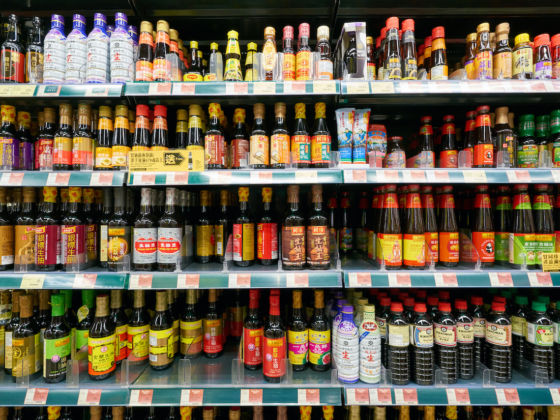

Every Type of Soy Sauce Around the World You Need to Try Before You Die
Soy sauce is far from a monolith. Its color can range from dark brown to amber to translucent yellow. It can be funky, add a salty kick to your dish, or create a smooth balance to fish and stew, depending on the quality and the way it’s been fermented. Even the texture can vary, ranging from a thick syrup to a thinner, more watery consistency.
Though the production process and recipe for soy sauce varies from country to country, the fundamentals are the same: Cooked soybeans are combined with fungal cultures (called aspergillus oryzae) to promote fermentation, and are then mixed with a salt brine to preserve the mixture while it brews, traditionally in clay pots. During this process, enzymes from the mold break down the beans’ proteins, oils, and starches and transform each one into amino acids, fatty acids, and sugar.
Once the fermentation process has finished, the solid beans are pressed to extract the liquid. Mass produced brands of soy sauce like Kikkoman, for instance, are chemically induced to ferment faster, sometimes in as little as two days. Higher quality soy sauce, on the other hand, is left to ferment and age for years at a time in vats, jars, and sometimes even ice cold chambers.
All over Asia, from China to Indonesia to Vietnam to Sri Lanka, soy sauce is a popular dipping sauce, condiment, and indispensable seasoning. These are the types of soy sauce from around the world to know.
Japanese soy sauces
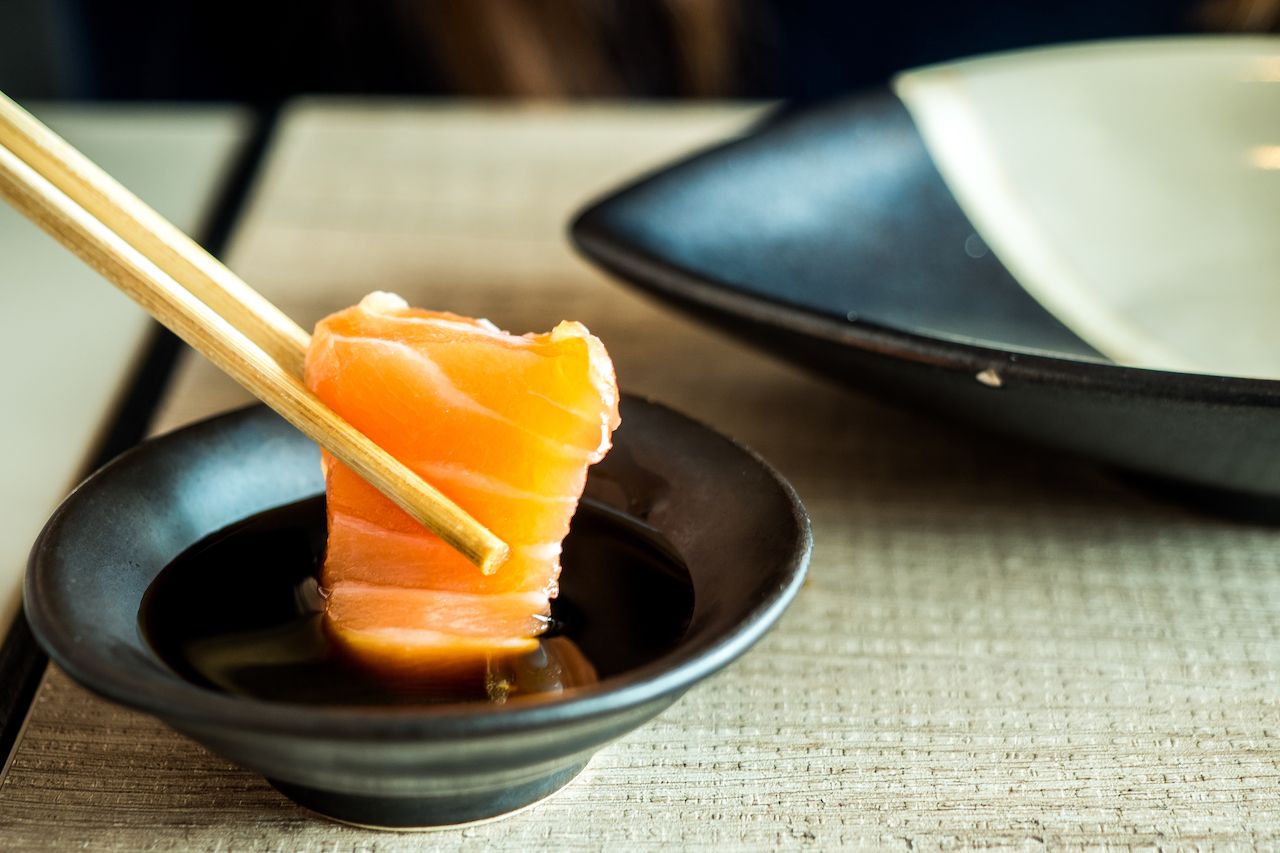
Photo: Ong.thanaong/Shutterstock
Buddhism is responsible for introducing soy sauce to Japan, where it became shoyu. Around the 13th century, monks from China settled in a coastal town called Yuasa and began brewing soy sauce. The Japanese people had their own ideas about how the soy sauce should taste, however: Soy sauce brewers implemented a 50/50 ratio of soybeans and wheat (traditional Chinese soy sauce was made with 100 percent soy, but modern iterations do contain a small amount of wheat), imbuing shoyu with a slightly sweet, fresh flavor and a thinner consistency.
The soybeans are cooked until soft and then mixed with roasted wheat. This mixture is combined with a special Japanese mold called koji, which catalyzes the fermentation process. It’s then all brewed in a salt brine, left to ferment, and aged (sometimes for six months, sometimes for many years) before being bottled.
There are five types of shoyu officially recognized by the Japanese Agricultural Standard. These fall into three grades, depending on quality: tokkyuu (special grade), ikkyuu (first grade), and hyoujun (standard grade). In addition to these, you might also encounter soy sauce with labels that include terms like nama-shoyu, soy sauce which has not been pasteurized; yuuki, soy sauce made with soybeans that haven’t been treated with chemicals (similar to organic); and marudaizu, soy sauce made with whole beans.
Koikuchi
The standard variety of Japanese soy sauce is sold by brands like Kikkoman and Yasama. It’s aged for six months before being bottled. This mildly salty and dark in color soy sauce is what you’re likely to find at your neighborhood Japanese restaurant. It’s an all-purpose soy sauce, equally good as a dip for gyoza as it is a marinade. Special reduced salt versions of koikuchi soy sauces are called genen.
Where to find it: Your local grocery store and online
Usukuchi
Usukuchi is richer in flavor, lighter in texture, and has a thin consistency. The primary feature of this soy sauce is that it’s much saltier than the standard koikuchi variety. It’s typically used sparingly due to its pungent flavor.
Where to find it: Asian speciality supermarkets and Amazon
Tamari
Originally a byproduct of miso, tamari differs greatly from typical Japanese soy sauce. It’s thicker and more viscose with a reddish-brown hue. It’s often used as a dipping sauce for sushi and sashimi, as well as a finishing sauce for teriyaki. Today, many brands of tamari are still made without wheat, making it popular among the gluten-free crowd. However, there might still be a trace of wheat in mass-produced tamari, so check the ingredients before buying.
Where to find it: Grocery stores like Target and Walmart
Saishikomi
Saishikomi means re-brewed, and the name says it all. The process involves making a regular batch of soy sauce using all the ingredients. Then a second batch is made, omitting salt and water so the mixture consists of just wheat and koji. The two batches are then combined, resulting in a sweet, thick sauce popular as a dipping sauce for sashimi. It’s the darkest in color of all the Japanese soy sauces and has a distinct umami flavor.
Where to find it: Speciality Asian markets or The Japanese Pantry
Shiro
The standout feature of this soy sauce is its color. Shiro is made with extra wheat like its sibling tamarin, and it’s fermented for only three months, giving it a translucent off-white or light yellow color (think dashi broth). The flavor is mild, refined, and slightly sweet. Shiro is a popular dipping sauce because it adds a touch of soy sauce flavor without discoloring the dish. It’s unlikely to be in stock at your local grocery store, so you might have to drop by a specialty Asian market if you want to try it.
Where to find it: Speciality Asian markets or MTC Kitchen
Jiàngyóu, or Chinese soy sauces

Photo: Rattiya Samakrat/Shutterstock
A paste fermented from soybeans first appeared in China in the second century. Called jiang, it was used first to pickle and preserve meat and vegetables, which were then served as side dishes. The first written reference to soy sauce doesn’t appear until the 13th-century Song Dynasty. By the 17th century, Dutch traders had begun exporting soy sauce around the world.
Known as zhiyou, jiàngyóu, or douyou depending on the dialect, Chinese soy sauce uses far less wheat than its Japanese counterpart. The best way to understanding the different varieties of Chinese soy sauce is to categorize them by color: light and dark. Light soy sauce is brewed, meaning that the soy sauce is fermented without additives, while the darker soy sauce is a blend that contains additives to sweeten the flavor.
Light soy sauce
Sometimes also known as “fresh” soy sauce, this variety is the most common in Chinese cuisine. It’s made from the first pressing of soybeans, and it tends to be lighter in color and saltier than its darker counterpart. Catonese recipes often call for light soy sauce, as it helps enhance the flavors of many dishes without discoloring the ingredients. Another version of light soy sauce is double fermented, resulting in a more complex flavor that lends itself well to a dipping sauce.
Dark soy sauce
What makes dark soy sauce stand out is that not only is it fermented longer than light soy sauces but also typically contain added sugar or molasses to create a thicker consistency and sweeter flavor. Dark soy sauce is used primarily during the cooking process, as it needs heat to help bring out its flavor.
Where to find it: Asian speciality supermarkets, Walmart, Amazon
Korean soy sauces
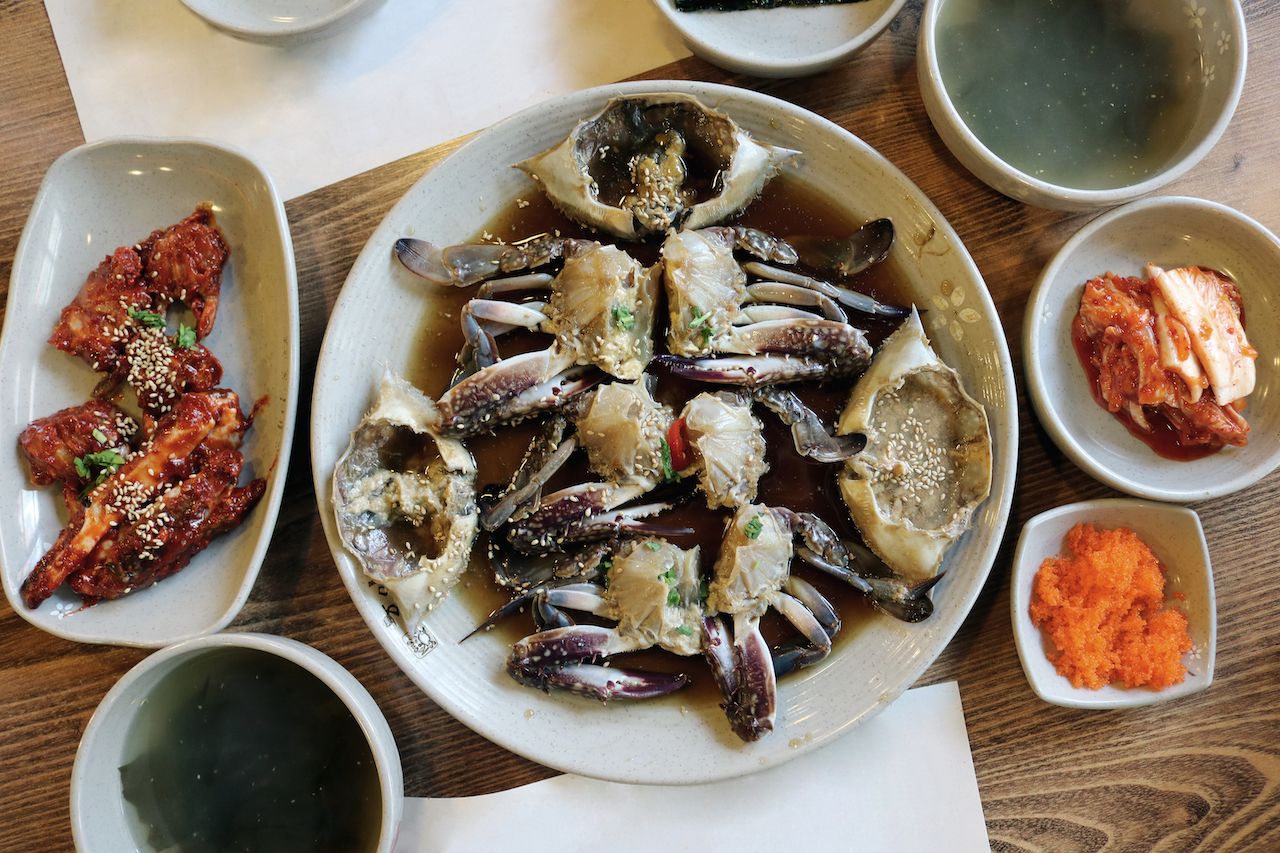
Photo: infinindy/Shutterstock
Ganjang, as soy sauce is known in Korea, might have emerged independent of soy sauce in China. Some accounts suggest that Koreans were experimenting with fermented soybeans before their Chinese neighbors. Soy sauce has been produced in Korea for at least 2,000 years, and records indicate that it was served at a royal wedding in 693 CE.
Ganjang is a byproduct of doenjang (fermented soybean paste) production. Korean soy sauce is made entirely from salt, soy beans, and water — no wheat. Meju, dried bricks of soybeans, are fermented alongside salt in traditional pots called onggi. Once fermentation is complete, the resulting liquid becomes soy sauce while the leftover aged pieces of meju are mashed to become doenjang. These two sauces along with gochujang, fermented chili paste, are the foundational elements of Korean cuisine.
Guk-ganjang
The traditional Korean soy sauce, strictly a by-product of doenjang, is called guk-ganjang, meaning soup soy sauce. It’s intended specifically to season soups and stews. It has a pungent, salty flavor (since it ferments in a brine not supplemented by any other preservatives) that’s packed with umami. The light color of guk-ganjang also makes it ideal for soup because it doesn’t discolor broth.
Where to find it: Speciality Korean markets like Gochujar
Whe-ganjang
Adopted from Japan around 1886, whe-ganjang is not a byproduct of doenjang. It has a much darker color than soup soy sauce and is used throughout the cooking process as a marinade, to braise meat, and as a dipping sauce. There are two types whe-ganjang: Yanjo-ganjang is the higher quality variety and is naturally brewed and fermented using soybeans, wheat or rice, and mold in a factory for six months before being bottled. Jin-Ganjang (sometimes also known as honhap ganjang), on the other hand, is a mixture of yanjo-ganjang and chemically fermented soy sauce, which relies on hydrochloric acid solution to break down the proteins in the soybeans, allowing them to ferment faster. Korea also produces mat ganjang, which are soy sauces flavored with additives like apple, mushroom, or garlic.
Where to find it: Speciality Korean markets like H Mart
Indonesian kecap manis
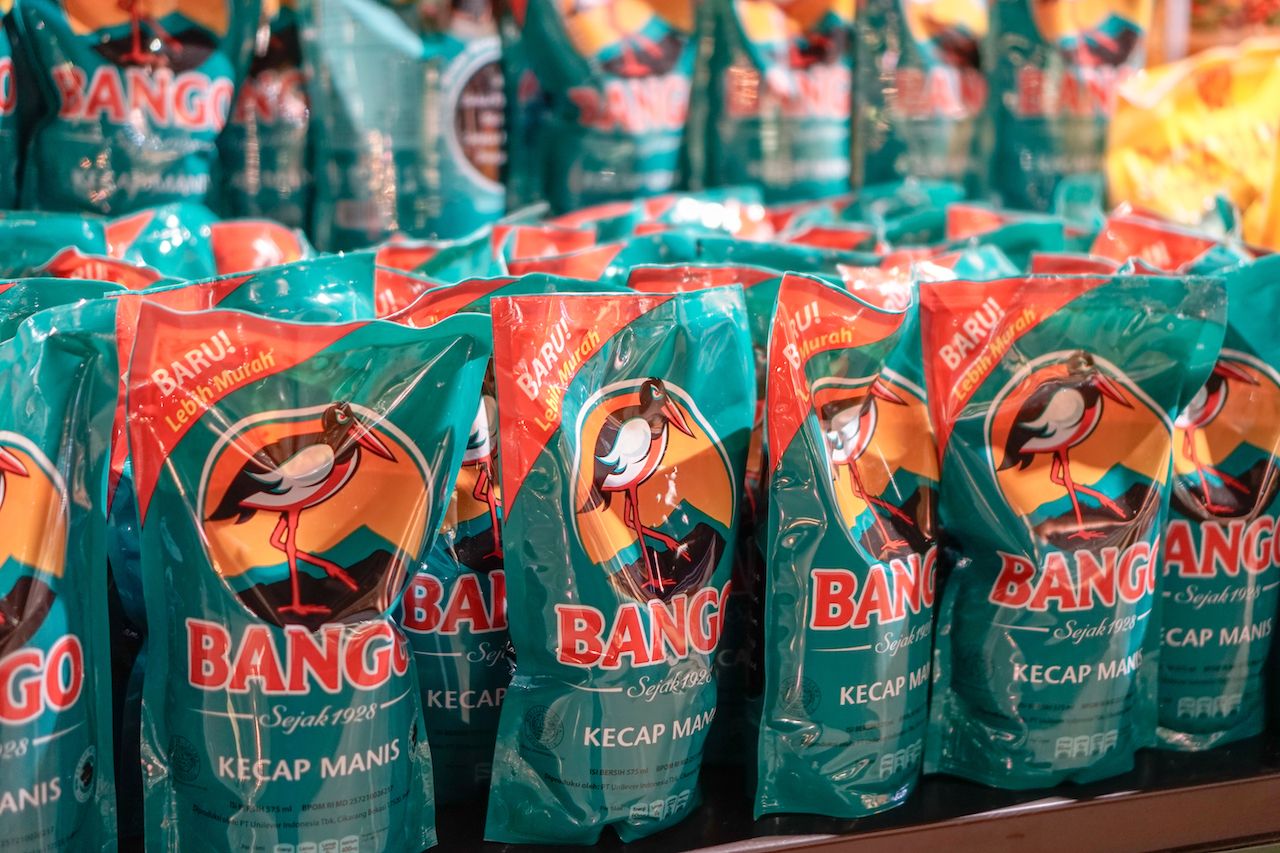
Photo: Mohd Syis Zulkipli/Shutterstock
In Indonesia, soy sauce is known as kecap manis, or sweet soy sauce. Soy sauce probably arrived in Indonesia in the 19th-century, around the time that Chinese people began settling on Java, the country’s largest island. To accommodate the Indonesian predilection for sweetness, soy sauce brewers added palm sugar to the recipe. Its name stems from the Chinese word for sauce, koe chiap (which also happens to be the root word for American ketchup).
There are distinct differences in the flavor and viscosity of kecap manis than other soy sauces in East Asia. Kecap manis is closer to the consistency of syrup, with a rich dark brown color and salted caramel flavor that’s reminiscent of molasses. It’s a central ingredient in classic Indonesian dishes like nasi goreng (fried rice) and babi kecap (pork braised in sweet soy sauce). Its salty counterpart is called kecap asin, which is similar to Chinese and Japanese soy sauce.
Soy sauce is also a popular ingredient in nearby Malaysia, where it’s known as kicap.
Where to find it: Speciality Indonesian grocery stores like Indo Food Store or Amazon
Sri Lankan soy sauce
In Sri Lanka, dark soy sauce, sometimes called soya sauce, is a key ingredient in the country’s legendary street food staple, kottu roti. The dish is similar to stir-fry, consisting of shredded roti alongside chopped onions, cabbage, and carrots seasoned with chili and curry powder. The mixture is tossed together and heated up in a wok.
Where to find it: Grocery stores in Sri Lanka like Keells
Taiwanese soy sauce
Taiwan specializes in soy sauce brewed with black soy beans. Traditionally, black soybean sauce is made in a similar fashion to Korean soy sauce. The black beans are placed in trays, where aspergillus oryzae is allowed to grow freely. Once the mold has begun to develop, they’re mixed with salt and water (no wheat) and poured into large clay urns. The mixture is then left to ferment in direct sunlight for 180 days. It has a mellow flavor with a sweet aftertaste, and a rich dark color. Taiwan is the only country to produce this type of soy sauce.
Though soy sauce likely originally arrived in Taiwan in the 17th century, when many Chinese people immigrated to the country, it didn’t become widespread until the Japanese colonial era (from 1895–1945). Around 1941, soy sauce began being mass produced in Taiwan.
Where to find it: Speciality grocery stores like Fish and Soy
Thai soy sauces
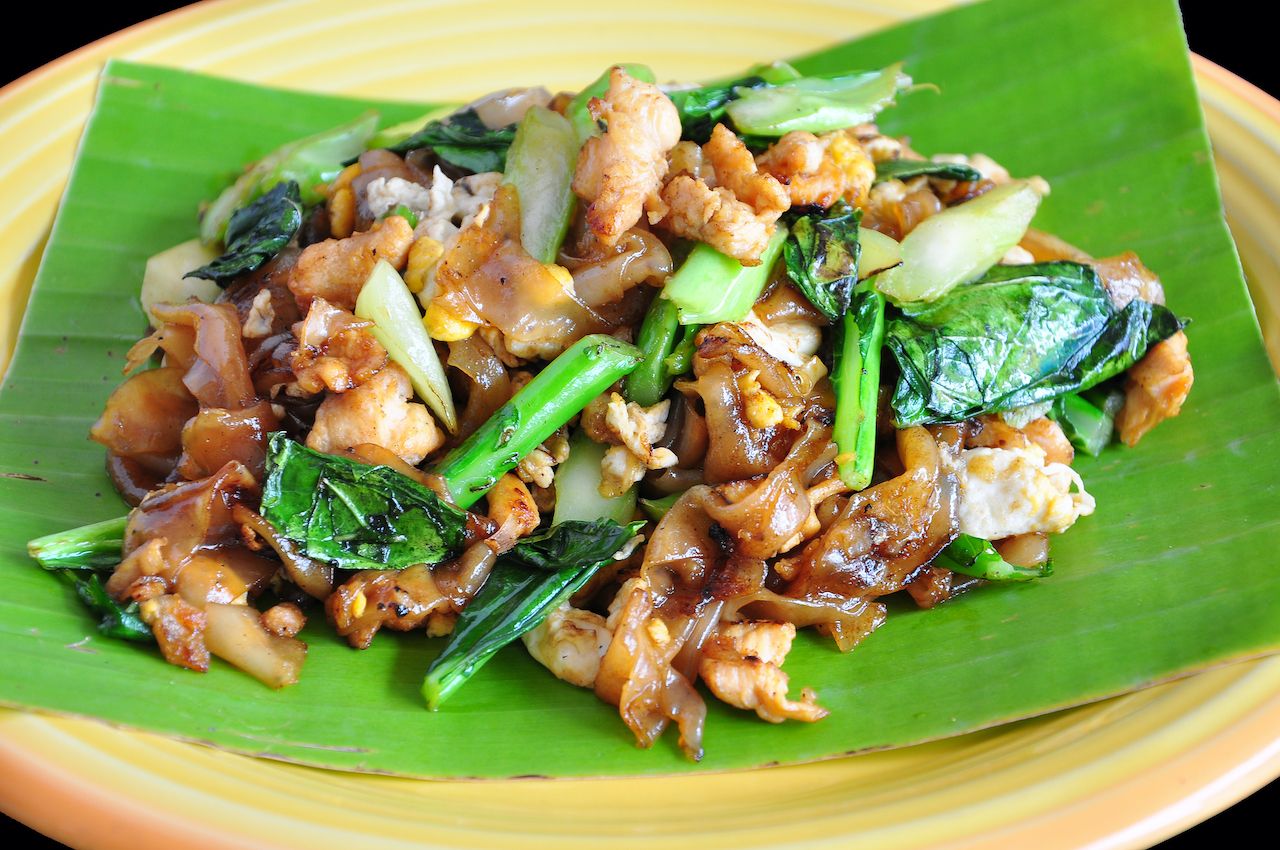
Photo: OLOS/Shutterstock
Like its Chinese counterpart, Thai soy sauce can also be broken down into two categories: light and dark. However, there are some key differences between Chinese and Thai soy sauce. Added sugar leans the flavor profile of Thai soy sauce toward sweet rather than salty. These soy sauces are used to braise meat, as a dipping sauce, or to add color your dish.
See ew khao
Also called light soy sauce or white soy sauce, this is the most basic, all-purpose type of Thai soy sauce. It’s a staple in most pantries and frequently appears in Thai recipes. One version is called Mushroom Light Soy Sauce and can be used interchangeably with unflavored Thai light soy sauce. The consistency of see ew khao is thin, similar to a Japanese soy sauce.
Where to find it: Speciality Asian grocery stores or Amazon
See ew dahm
This dark soy sauce is slightly reminiscent of kecap manis — it’s viscous, and added palm sugar or molasses gives it a distinct sweet, rather than salty, flavor. Another version of dark soy sauce, called see ew wan is even sweeter, takes on syrupy texture, and is applied to noodle dishes like pad see ew and stir fries and can also be used as a dipping sauce. See ew wan is much less common than light soy sauce or even regular dark soy sauce.
Where to find it: Speciality Asian grocery stores or Amazon
Vietnamese soy sauce
The Vietnamese take on soy sauce is called nước tương (a version closer to Chinese-style soy sauce is known as xì dầu). Similar to soy sauces in Thailand and Indonesia, nước tương is thick in texture, but it also features a salty, slightly sour flavor. The production of soy sauce is slightly different in Vietnam than it is in the rest of Asia. Firstly, the soybeans are roasted before fermentation begins. And while most other soy sauces are pressed to extract the liquid from the solid beans after fermentation, Vietnamese soy sauce is ground, resulting in that thicker consistency. Nước tương is generally served as a condiment for vegetables. One especially famous variety called tuong ban is a caramel brown color and is only made in the North Vietnamese village of Ban.
Where to find it: Online grocery stores based overseas, such as Zing Asia